Passion Week
[Note: This post breaks down some of the key events that happened in the days leading up to Passover and Easter. Passover which follows the Hebrew lunar calendar, falls on a different day, each year. I use Sunday-to-Sunday in this post mainly because Palm Sunday and Easter are always celebrated on Sundays and this gives us a rough framework (disclaimer: some details may not line up accurately) which helps us follow along and reflect on events as they unfolded that week.]
Sunday: Jesus began his last trip to Jerusalem, knowing his time there would result in his death. He stopped at Bethpage on the way and sent two of his disciples ahead to look for a young donkey and instructed them to bring it to him.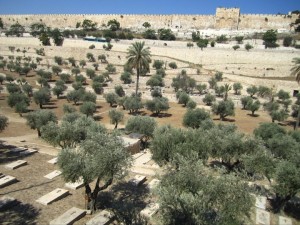
Jesus made his entry into Jerusalem on this donkey, fulfilling prophecy (Zechariah 9:9). Crowds had already gathered to see who this Jesus was. They waved palm branches in the air and welcomed him, shouting “Hosanna to the Son of David! Blessed is he who comes in the name of the Lord! Hosanna in the highest!”
Why a donkey? Because Jesus came in humility, in peace; not as a conquering king on a horse after a military conquest.
Why palm branches? Because palm branches are symbols of victory and celebration. Traditionally, a victorious king returning to his kingdom after a big conquest was greeted by throngs of people waving palm branches. The crowds welcomed Jesus hoping that he was the Messiah who would save them from Roman oppression. Little did they understand that Jesus was ushering in a kingdom of another kind altogether.
Why “Hosanna!?” The term “hosanna” refers to God who saves us. It was also a cry for a savior as well as a cry for freedom. (Mark 11:1-11)
That night, Jesus and the disciples stayed in Bethany (two miles east of Jerusalem). Maybe they stayed in the home of Mary, Martha, and Lazarus. Bethany is also where, just a few days ago, Mary had washed Jesus’ feet with expensive perfume. (John 12:1-11)
Monday: On his way to Jerusalem from Bethany, Jesus cursed a fig tree because it failed to bear fruit – a statement that true faith must bear good fruit in a person’s life. (Matthew 21:18-19)
Then he arrived in the temple to find it full of corrupt money changers and merchants. He aggressively cleaned out the temple saying ‘My Temple will be a house of prayer, but you’ve made it into a den of robbers.” (Matthew 21:12-22)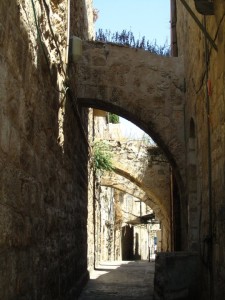
Tuesday: As they passed the now withered fig tree on their way back to Jerusalem, Jesus taught his disciples on faith (Mark 11:20-26). He later used harsh language in confronting religious leaders of his time who challenged his authority (“Outwardly you look like righteous people, but inwardly your hearts are filled with hypocrisy and lawlessness!” (Matthew 23:24-33)
Mark 12 narrates other events that may have happened this day: Jesus told the parable of the tenants. Matthew 25 also records two other parables that he may have told on this day – the parable of the ten virgins and the parable of the talents.
He interacted with a variety of people. The Pharisees questioned him about paying taxes to Caesar. The Sadducees asked him questions about the resurrection. One of the scribes asked him, “What is the greatest commandment of all?” leading to Jesus’ answer, “Love the Lord your God with all your heart and with all your soul and with all your mind and with all your strength. And love your neighbor as yourself.” He warned his followers of hypocritical scribes.
Later he watched people bringing their offerings to the temple. Seeing a poor widow put 2 small copper coins into the offering box, he said, “This poor widow has put in more than all those who are contributing to the offering box. For they all contributed out of their abundance, but she out of her poverty has put in everything she had, all she had to live on.”
In the afternoon, he went up the Mount of Olives with his disciples (overlooking Jerusalem and the temple) and spoke at length to them about the soon to come destruction of Jerusalem and the temple. He also foretold what would happen in the future (Matthew 24:1–25:46) and of the time when he would return again. “It is like a man going on a journey, when he leaves home and puts his servants in charge, each with his work, and commands the doorkeeper to stay awake. Therefore stay awake—for you do not know when the master of the house will come, in the evening, or at midnight, or when the rooster crows,or in the morning lest he come suddenly and find you asleep. And what I say to you I say to all: Stay awake.” (Mark 13:34-36) He spoke of the final judgement. (Matthew 25)
Wednesday: Two days before the Passover (Mark 14, Matthew 26) Jesus told his disciples, “You know that after two days the Passover is coming, and the Son of Man will be delivered up to be crucified.” The chief priests and the scribes planned how to arrest Jesus by stealth and kill him. “Not during the feast, lest there be an uproar from the people.”
This was possibly the day Judas sealed his deal with the Sanhedrin and began looking for opportunities to betray him. (Mark 14:10-11)
While Jesus relaxed in the home of Simon the Leper, in Bethany, a woman with an alabaster flask of pure, expensive nard, came to him, broke the flask and poured it over his head. (Mark 14) Some of his followers criticized this harshly by calling it wasteful. Jesus: “She has anointed my body beforehand for burial.”
The Bible is mostly silent on what happened this day. Jesus could have spent more time at the temple, talking to people or teaching. Maybe he spent time in prayer preparing for the Passover which was now two days away.
Thursday: Jesus sent Peter and John (from Bethany to the Upper Room in Jerusalem) to make preparations for the Passover meal. When all were gathered together in this room, after sunset, Jesus washed his disciples’ feet (showing us how to love and serve one another).
During the meal, he told them this would be his last Passover meal and that he wouldn’t eat it again till everything the special meal symbolized was fulfilled. (Luke 22:15-16)
Just as flawless lambs had been sacrificed every Passover (symbols of redemption to come) since Moses’ time, Jesus, the Lamb of God, was now about to sacrificed – his body would soon to be broken and his blood shed in sacrifice, freeing us from sin and death, once and for all.
Judas left the group to betray Jesus. After the meal, Jesus and the disciples 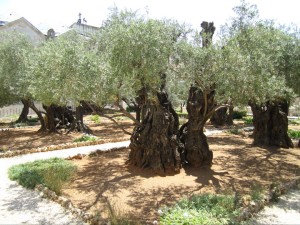 headed to the Garden of Gethsamane on the Mount of Olives where he prayed in agony, fully understanding the horrific death that lay before him and yet embracing it as part of God’s plan. (Luke 22:39-46)
headed to the Garden of Gethsamane on the Mount of Olives where he prayed in agony, fully understanding the horrific death that lay before him and yet embracing it as part of God’s plan. (Luke 22:39-46)
In the garden, Jesus was arrested by the Sanhedrin after Judas betrayed him with a kiss. The other disciples fled in different directions, abandoning Jesus in the chaos that followed. Jesus was then taken to Caiaphas, the High Priest’s house where the religious council had gathered. There they began building a case against him.
While all this was going on, Peter who hung around trying to learn what was happening to Jesus, was recognized by three in the crowd as one of Jesus’ disciples. Peter denied Jesus three times before the rooster crowed (just as Jesus had foreseen) ushering in the dawn of a long and eventful friday.
Friday: By early morning Jesus had already been condemned by the chief priests and elders for (their charge: blasphemy). He had been tried by Annas (the previous high priest) and then Caiaphas (the current high priest) and then by the Sanhedrin (Jewish council of priests and elders). As people under Roman occupation, they lacked the authority to put him to death, so they took him to Pontius Pilate.
Meanwhile, Judas, overcome with remorse, hung himself. (Matthew 27:3-9)
Jesus endured the continuing barrage of false accusations, condemnation, mockery and trials before Pilate, Herod and then Pilate once again who finally washed his hands off of Jesus declaring himself to be innocent of the blood of ‘this just person’ while at the same time sentencing him to brutal flogging and death by crucifixion–one of the most horrible and disgraceful methods of capitol punishment. (Matthew 27:15-26)
After the brutal scourging (which very few survived), with a robe thrown on him, a crown of thorns on his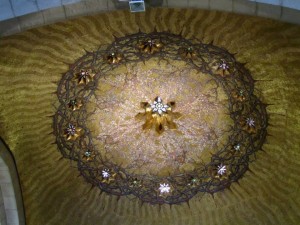 head and a reed forced into his hands, Jesus was hit and spit at and mocked as the ‘king of the Jews’ (Mark 15:16-20). An already dying Jesus was then made to carry his own cross to Calvary where Roman soldiers nailed him to a wooden cross between two thieves. A sign was nailed to his cross that said ‘King of the Jews’ and the mocking continued. (Luke 22:26-43)
head and a reed forced into his hands, Jesus was hit and spit at and mocked as the ‘king of the Jews’ (Mark 15:16-20). An already dying Jesus was then made to carry his own cross to Calvary where Roman soldiers nailed him to a wooden cross between two thieves. A sign was nailed to his cross that said ‘King of the Jews’ and the mocking continued. (Luke 22:26-43)
The soldiers gambled for Jesus’ robe. This event and many others that happened this friday happened exactly as prophets had once foretold.
At noon, darkness fell over the land that lasted till 3pm when Jesus cried out and then took his last breath.
The soldiers broke the legs of the crucified to speed up death so the bodies could be buried before the fast approaching Sabbath. When they got to Jesus, they found him to be already dead. They pierced his side to verify that he was truly dead.
The Gospels record seven statements Jesus said from the cross, each one giving us deep insight into his heart during those final hours. His first words were, “Father, forgive them, for they do not know what they are doing.” (Luke 23:34 NIV). His last were, “Father, into your hands I commit my spirit.” (Luke 23:46)
By 6pm, Nicodemus and Joseph of Arimathea, with Pilate’s permission, took Jesus’ body down from the cross, wrapped it in linen, hastily laid it in a garden tomb hewn out of rock and rolled a big stone over the door of the tomb just before the Sabbath began.
Read more: Matthew 271-61, Mark 15, Luke 22:66-71 to 23:-1-55, John 18:28-40, 19:1-42
Saturday: This was the Sabbath and a day of silence as Jesus’ body lay in the garden tomb. Since the religious leaders 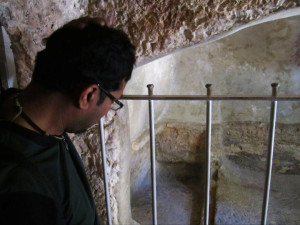 feared the body would be stolen away by his disciples who could then claim that he was risen from the dead, they pleaded with Pilate for help and Roman soldiers were sent to to guard it. A seal was placed on the stone wall of the tomb as well. (Matthew 27:62-66)
feared the body would be stolen away by his disciples who could then claim that he was risen from the dead, they pleaded with Pilate for help and Roman soldiers were sent to to guard it. A seal was placed on the stone wall of the tomb as well. (Matthew 27:62-66)
Nicodemus, like Joseph of Arimathea, was a member of the Sanhedrin, the court which had condemned Jesus Christ to death. However, both men had lived as secret followers of Jesus for a while now, probably afraid to be open about their faith because of their prominent positions in the Jewish community.
Now they boldly came ‘out of hiding’, risking everything, readily owning that Jesus really was the promised Messiah. They had taken Jesus’ body down from the cross, prepared it for burial and buried it in what was most probably Joseph’s garden tomb.
We can only imagine what was happening in the unseen world on this silent day… While Jesus’ physical body lay dead in the tomb, he was actually paying the penalty for our sin and conquering death, securing our eternal salvation and life.
Once and for all.
“For you know that it was not with perishable things such as silver or gold that you were redeemed from the empty way of life handed down to you from your ancestors, but with the precious blood of Christ, a lamb without blemish or defect.” (1 Peter 1:18-19)
Read more: Matthew 27:62-66, Mark 16:1, Luke 23:56, and John 19:40
Sunday: What a glorious morning! A violent earthquake, an angel coming down from heaven to 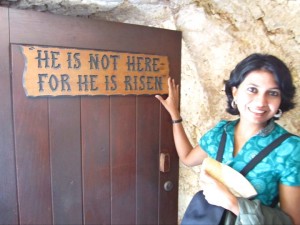 open the tomb, and most wonderful of all – a resurrected Jesus!
open the tomb, and most wonderful of all – a resurrected Jesus!
The angel rolled the stone away from the tomb’s entrance and then sat on it. He looked like lightning and his clothes were as white as snow. The Roman guards were paralyzed by fear.
A little later, Mary Magdalene, Mary the mother of James, Joanna, and Salome (mentioned in the Gospel accounts) went to the tomb to anoint Jesus’ body. They saw that the stone had been rolled away. As they entered the tomb, they saw a young man dressed in a white robe sitting on the right side, causing them great alarm. (Mark 16:1-14)
“Don’t be afraid!” said this angel. “I know you are looking for Jesus, who was crucified. He isn’t here! He is risen from the dead, just as he said would happen. Go quickly and tell his disciples…” (Matthew 28:5-6)
As the women (Mary Magdalene did not leave with them) ran to tell the disciples, Jesus himself met them. They clasped his feet and worshiped him. He sent them on to tell the disciples to wait for him in Galilee.
The disciples did not believe the women.
Mary Magdalene ran to Peter and John and told them that Jesus’ body was missing. They ran back to the tomb to see for themselves that the tomb was empty, but they didn’t understand what had happened and returned home. (John 20:1-9)
Mary Magdalene stayed weeping outside the tomb. Her encounter with the risen Jesus is beautifully described in John 20:11-17.
The Roman guards reported to the chief priests and elders what had happened. They were then bribed and  asked to spread a lie (that Jesus’ body was stolen by his disciples while the guards slept). This lie is still believed by some today. (Matthew 28:11-15)
asked to spread a lie (that Jesus’ body was stolen by his disciples while the guards slept). This lie is still believed by some today. (Matthew 28:11-15)
The Gospels record at least five appearances made by Jesus that resurrection day. Jesus appeared to Mary Magdalene, to the other women, to two of his followers on the road to Emmaus, to Peter, and later that day to all of the disciples (except Thomas who would not believe till he saw Jesus a week later) while they were gathered in a house for prayer, terrifying them. He showed them his hands, his feet and his side. The disciples now believed and were overjoyed!
These accounts were written that we may believe that Jesus is the Messiah, the Son of God, and that by believing we may have life in his name.
Jesus is risen! He is risen indeed! Hallelujah what a Savior!
Read more: Matthew 28:1-13, Mark 16:1-14, Luke 24:1-49, and John 20:1-23
~shini abraham, ©2013, duco divina – contemplative doodling

Recent Comments